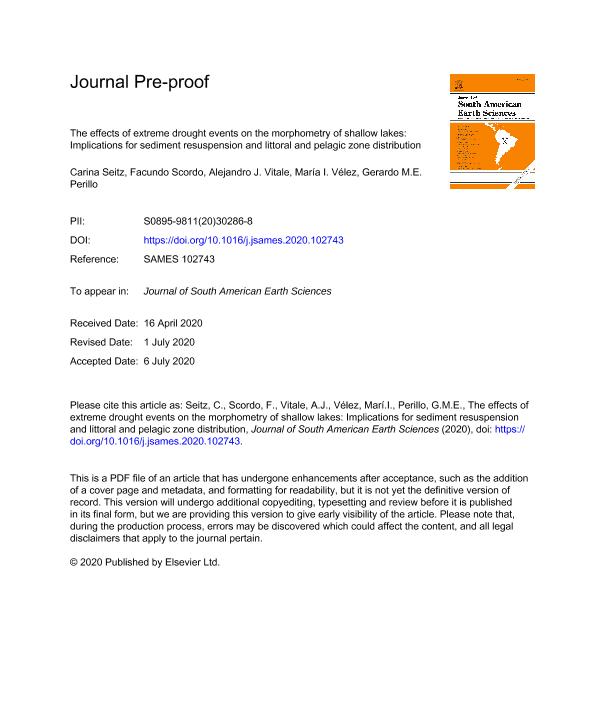Mostrar el registro sencillo del ítem
dc.contributor.author
Seitz, Carina

dc.contributor.author
Facundo, Scordo

dc.contributor.author
Vitale, Alejandro José

dc.contributor.author
Vélez, María I.
dc.contributor.author
Perillo, Gerardo Miguel E.

dc.date.available
2021-09-02T01:20:09Z
dc.date.issued
2020-11
dc.identifier.citation
Seitz, Carina; Facundo, Scordo; Vitale, Alejandro José; Vélez, María I.; Perillo, Gerardo Miguel E.; The effects of extreme drought events on the morphometry of shallow lakes: Implications for sediment resuspension and littoral and pelagic zone distribution; Pergamon-Elsevier Science Ltd; Journal of South American Earth Sciences; 103; 102743; 11-2020; 1-34
dc.identifier.issn
0895-9811
dc.identifier.uri
http://hdl.handle.net/11336/139497
dc.description.abstract
Shallow lakes, because of their depth, are more vulnerable to the effects of wind and changes in precipitation and evaporation that deeper lakes and thus respond more dramatically to extreme climatic events, such as drought. The morphology of shallow lakes influences many of their physical, chemical, biological and sedimentological processes including sediment resuspension. Sediment resuspension can trigger undesired effects such as eutrophication, increase in turbidity, cyanobacterial blooms, and also affects the distribution and extent of the littoral and pelagic zones (habitat distribution) with potentially negative consequences on biodiversity and loss of native species. These problems are an increasing concern in the face of global warming. To understand how changes in lake' morphometry, triggered by extreme drought events influence sediment resuspension and habitat distribution, we studied four shallow lakes located in the southwest of the Argentinean Pampas. Each lake was characterized by its bathymetry, morphometric parameters (including area, shore development, dynamic ratio, critical depth), the spatial distribution of the littoral and pelagic areas, and the effect of the waves on sediment resuspension. We measured the Area and Shore development again during selected extreme drought periods identified through the Standardized Precipitation-Evapotranspiration Index. Then, for the given drought period, we calculated the extent and distribution of littoral and pelagic areas and the critical depth at which sediment resuspension occurred and then estimated the percentage of the lake that would be affected by it. We found that Pampean lakes are profoundly affected by sediment resuspension triggered by wind during extreme dry events. Droughts have different effects depending on lake morphology. Dry periods caused not only a decrease in water volume, but also modified the extension of littoral and pelagic zones and increased sediment resuspension. These results have significant implications for the preservation of these rich ecosystems, especially in the context of global warming.
dc.format
application/pdf
dc.language.iso
eng
dc.publisher
Pergamon-Elsevier Science Ltd

dc.rights
info:eu-repo/semantics/openAccess
dc.rights.uri
https://creativecommons.org/licenses/by-nc-sa/2.5/ar/
dc.subject
CLIMATE VARIABILITY
dc.subject
DRY EVENTS
dc.subject
LAKE MORPHOMETRY
dc.subject
SEDIMENT RESUSPENSION
dc.subject
SHALLOW LAKES
dc.subject
UNMANNED SURFACE VESSEL (USV)
dc.subject.classification
Geociencias multidisciplinaria

dc.subject.classification
Ciencias de la Tierra y relacionadas con el Medio Ambiente

dc.subject.classification
CIENCIAS NATURALES Y EXACTAS

dc.title
The effects of extreme drought events on the morphometry of shallow lakes: Implications for sediment resuspension and littoral and pelagic zone distribution
dc.type
info:eu-repo/semantics/article
dc.type
info:ar-repo/semantics/artículo
dc.type
info:eu-repo/semantics/publishedVersion
dc.date.updated
2021-08-19T20:00:28Z
dc.journal.volume
103
dc.journal.number
102743
dc.journal.pagination
1-34
dc.journal.pais
Estados Unidos

dc.description.fil
Fil: Seitz, Carina. Consejo Nacional de Investigaciones Científicas y Técnicas. Centro Científico Tecnológico Conicet - Bahía Blanca. Instituto Argentino de Oceanografía. Universidad Nacional del Sur. Instituto Argentino de Oceanografía; Argentina. Universidad Nacional del Sur. Departamento de Geología; Argentina
dc.description.fil
Fil: Facundo, Scordo. Consejo Nacional de Investigaciones Científicas y Técnicas. Centro Científico Tecnológico Conicet - Bahía Blanca. Instituto Argentino de Oceanografía. Universidad Nacional del Sur. Instituto Argentino de Oceanografía; Argentina. Universidad Nacional del Sur. Departamento de Geografía y Turismo; Argentina. University of Nevada; Estados Unidos
dc.description.fil
Fil: Vitale, Alejandro José. Consejo Nacional de Investigaciones Científicas y Técnicas. Centro Científico Tecnológico Conicet - Bahía Blanca. Instituto Argentino de Oceanografía. Universidad Nacional del Sur. Instituto Argentino de Oceanografía; Argentina. Universidad Nacional del Sur. Departamento de Ingeniería Eléctrica y de Computadoras; Argentina
dc.description.fil
Fil: Vélez, María I.. University of Saskatchewan; Canadá
dc.description.fil
Fil: Perillo, Gerardo Miguel E.. Consejo Nacional de Investigaciones Científicas y Técnicas. Centro Científico Tecnológico Conicet - Bahía Blanca. Instituto Argentino de Oceanografía. Universidad Nacional del Sur. Instituto Argentino de Oceanografía; Argentina. Universidad Nacional del Sur. Departamento de Geología; Argentina
dc.journal.title
Journal of South American Earth Sciences

dc.relation.alternativeid
info:eu-repo/semantics/altIdentifier/url/https://linkinghub.elsevier.com/retrieve/pii/S0895981120302868
dc.relation.alternativeid
info:eu-repo/semantics/altIdentifier/doi/http://dx.doi.org/10.1016/j.jsames.2020.102743
Archivos asociados
